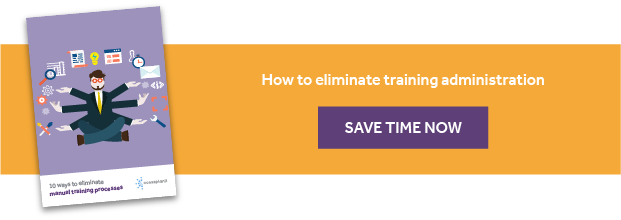Moments Of Truth: Bouncing Back From Service Failure

Service failure is an unspoken topic throughout many businesses as it can be difficult to admit when we fail to meet customer expectations. Receiving criticism can be brutal but it is crucial to make the most of that feedback to make improvements and prevent future dissatisfaction. For training companies, it can be challenging to measure and assess course delivery accurately. And, when you do receive meaningful feedback it can be equally as difficult to know the most effective way to handle it.
How do you find out when you have not met expectations? What do you do when you have failed your customers? Is there a way to successfully recover from failure?
So firstly, how do you know when customer expectations have not been met? According to 1st Financial Training, 96% of unhappy customers don’t complain to the service provider which leaves a worrying number of customers who leave without warning.
What’s more concerning is that many more customers complain only to family and friends. Often, companies assume that if customers don’t complain then they must be satisfied. Negative word of mouth can be extremely dangerous as it is the strongest influence of consumer behaviour and is almost impossible to control.
How can you prevent failure?
Of course, there is no way to completely eliminate failure from any business but putting measures in place can go a long way to reduce the likelihood.
One of the best ways to reduce the chances of not meeting customer expectations is by being prepared. Start with a pre-course evaluation form to find out what your learners expect from the course before they arrive. Read more on creating winning training surveys here.
Another way to prepare for learners needs effectively is by understanding their existing knowledge and subject level in order to assign them to the correct cohort. There is nothing less satisfying for learners than attending a course which doesn't challenge them or indeed where they feel out of their depth.
By being proactive rather than reactive you can establish the objectives of your learners and tailor courses in order to meet their needs.
Top tip: Pre-course survey results can be compared with post-course evaluation forms to identify if delegate needs were met or not. Read on for more on this topic.
Using feedback to make service improvements
It is important to ask the right kind of questions to ensure that you gain as much insight as possible during evaluation activities. For example, it might be a good idea to ask delegates how they rate their experience in different areas on a scale of 1-10. This provides a consistent measure and therefore you are more likely to receive consistent and measurable results.
Use a variety of question types to get the most effective feedback. Remember, just as learning styles differ so do survey styles. Some respondents will prefer tick boxes and radio buttons whereas others will welcome the opportunity to explain their answer and provide detailed opinions and feedback.
The more information you gather, the more you can improve your customer experience. However, it is all about finding the right balance, nobody wants to fill out a 20-page questionnaire.
Use data gathered to continuously close gaps in your training courses and enhance your strengths.
Providing customers with regular feedback opportunities such as surveys mentioned above or on your website is also a fantastic way to show how customer-focused you are.
Believe it or not, bad reviews are not always negative.
Naturally, you don't want too many bad reviews but consumers expect mixed reviews and if feedback is all positive they may not find the experiences as believable.
Recovering from failure
Making improvements from failures is a different thing to recovering from failure. Recovery includes acknowledgment and putting steps in place to ensure that your reputation is impacted as little as possible. The two key factors that need to be played out are:
Address and accept any issues that customers have raised
Contact all customers who provide negative feedback and ask for more information. This gives you the chance to focus on your weaknesses and enhance your strengths. It also makes your customers feel valued as you are demonstrating your willingness to listen to their opinions.
Demonstrate improvements made following customer feedback
Once you have made improvements, let your customers know! This can be in the form of a public announcement such as a quarterly blog post where you outline all enhancements made due to customer feedback.
Or, you can inform customers directly and let them know how their input has been put into practice. You may even offer a course discount for them to experience the improvements first hand.
Another great way of improving course delivery and minimising the risk of failure, is through the use of training software and tools.
Using automation to improve course delivery
With a training session of 40 or more delegates, the last thing you want to contend with at the end of the programme is collating the results of ‘happy sheets’ that were handed out at the end. Inevitably, some will be filled out in a rush and are illegible, so completely useless.
Automated software issues and collects surveys online. With answers typed instead of written they are all legible, and the software will also collate and format answers, providing an at-a-glance data overview, i.e. 25% of delegates rated the informal discussion as ‘excellent’.
There is a whole host of different software packages available on the market today that aid in enhancing course delivery from surveys to standardised communications to regular reports to identify service enhancements and improvements.
With a training management system, the risk of duplication, human error and service failure are eliminated. Read more about 10 ways to automate training with a copy of our whitepaper.
Other articles you might find interesting include:
How LMS Supports Globalised Uniformity In Training Companies
How LMS Can Help You Lead Employees Successfully
The Life Of A Customer Success Manager
Musgrave Support 55,000 Learners With accessplanit Software



..png?width=270&height=170&name=The%20hidden%20costs%20of%20training%20management%20(and%20how%20to%20fix%20them)..png)